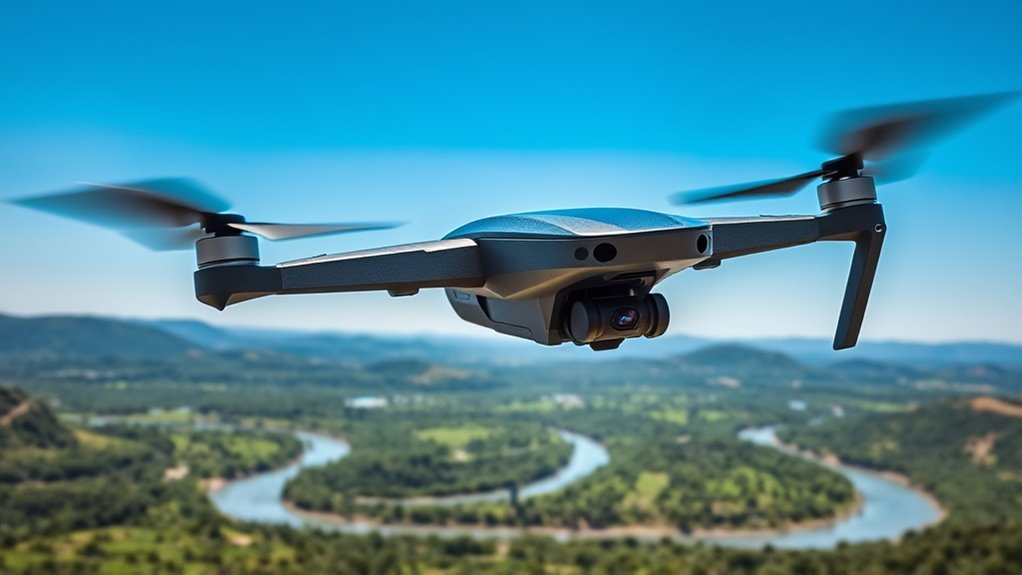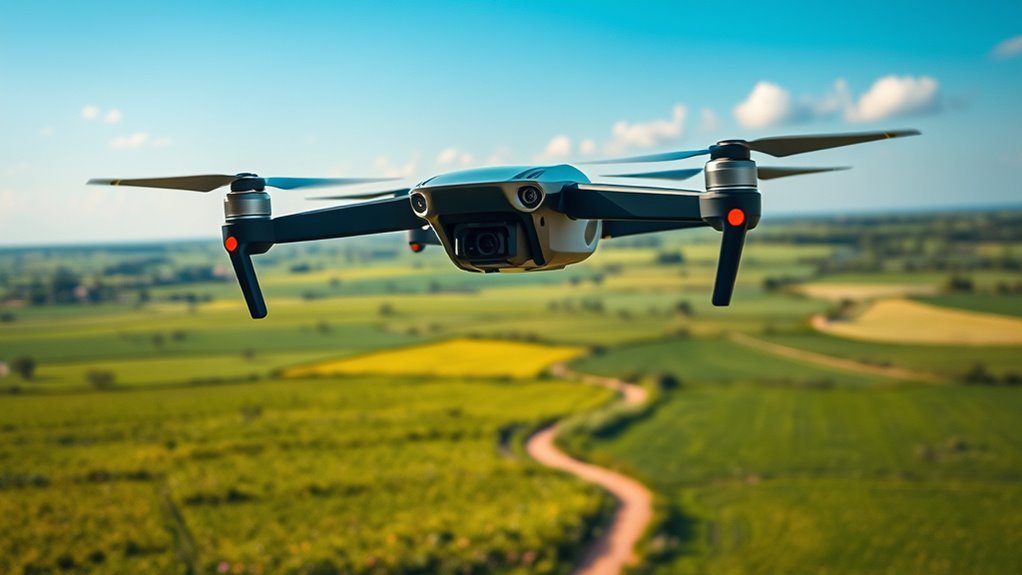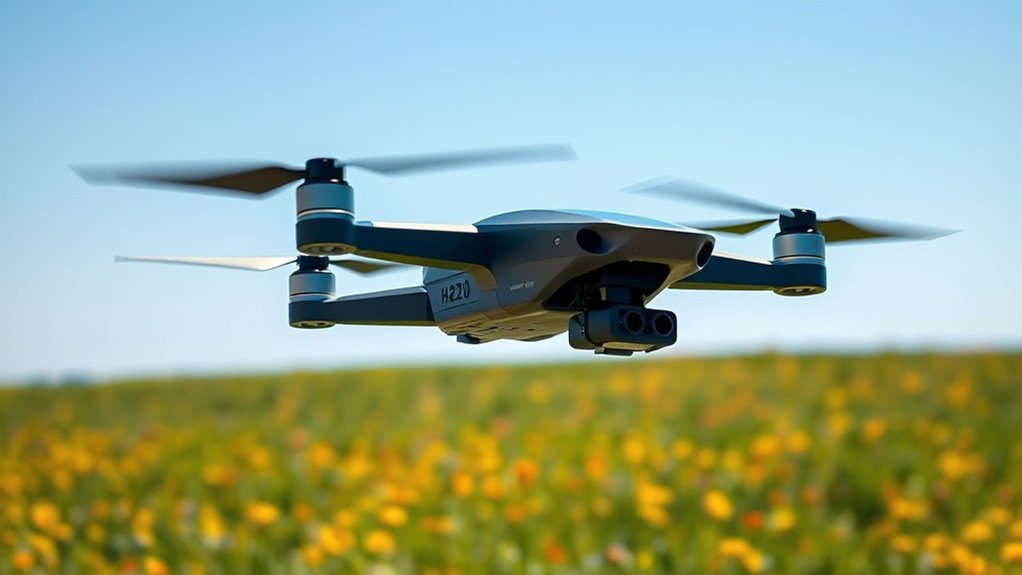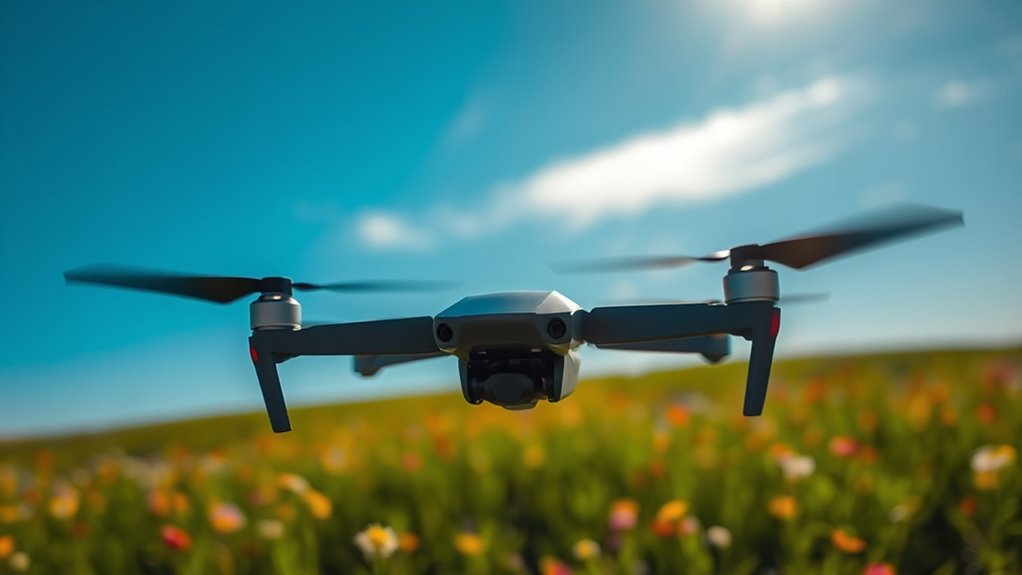The HS210 drone is a compact, durable option perfect for beginners, featuring smart connectivity and easy controls like one-key takeoff. You’ll get about 7 minutes of flight time and a 720p camera that’s decent but not professional-grade. Its lightweight build offers stability and crash resistance, making it forgiving for new pilots. While the battery life is short, extra batteries help. If you want to know how it stacks up with similar models and more details, keep exploring.
Design and Build Quality

The Hs210 drone’s design prioritizes compactness and durability, making it easy for you to handle and transport. Its streamlined frame not only enhances aesthetic appeal but also contributes to aerodynamic efficiency, allowing for smoother flight experiences. You’ll appreciate the use of high-grade plastic materials that balance lightweight construction with robust resistance to impacts and wear. The material quality guarantees your drone withstands minor crashes and rough outdoor conditions, offering long-term reliability. Its minimalist design supports quick assembly and disassembly, empowering you to deploy or pack up swiftly. This focus on design and build quality aligns with your desire for freedom, as it reduces constraints related to fragility or bulkiness, letting you explore and capture without hesitation or concern for damage.
Key Features and Specifications

Although compact in size, the Hs210 drone packs a range of features designed to optimize your flying experience. It incorporates smart technology integration, allowing seamless connectivity with your smartphone for real-time video and easy control. The drone’s user friendly interface guarantees that whether you’re a beginner or experienced pilot, you can quickly access settings and execute commands without hassle. Key specifications include a lightweight frame, a 720p HD camera for clear aerial shots, and stable hovering capabilities. Its battery life offers around 7 minutes of flight time, balancing performance with portability. The inclusion of altitude hold and one-key takeoff/landing functions further simplifies operation, giving you the freedom to focus on exploration and creativity rather than technical complexity.
Flight Performance and Controls

When you pilot the Hs210, you’ll notice its maneuverability and stability are designed to handle both smooth and turbulent conditions effectively. The controls respond quickly, allowing precise adjustments without lag. Additionally, the variety of flight modes offers flexibility to suit different skill levels and flying environments.
Maneuverability and Stability
You’ll notice that the Hs210 drone offers precise maneuverability, responding swiftly to control inputs without lag. This responsiveness stems from its aerodynamic design, which minimizes air resistance and allows for agile directional changes. Stability factors such as a low center of gravity and balanced weight distribution contribute to steady flight, even in moderate wind conditions. The drone’s frame rigidity also reduces vibrations, enhancing control accuracy during complex adjustments. These elements combine to deliver a flight experience where you feel both in command and free to explore. Whether traversing tight spaces or cruising open areas, the Hs210’s maneuverability and stability provide reliable performance, allowing you to focus on capturing your desired shots without worrying about sudden flight disruptions.
Control Responsiveness
Control responsiveness is a critical aspect that defines the Hs210 drone’s overall flight performance. When you pilot this drone, you’ll notice minimal control latency, which means your commands translate into immediate movements. This responsiveness grants you a sense of freedom and precision, essential for confident flying.
Here’s what you can expect regarding control responsiveness:
- Low Control Latency: Inputs register almost instantaneously, reducing lag and improving your ability to react swiftly.
- Clear User Feedback: The drone’s responsive controls provide intuitive feedback, allowing you to anticipate and adjust movements effortlessly.
- Consistent Response: Whether performing gentle maneuvers or quick turns, the drone maintains steady control responsiveness, reinforcing your command over flight.
Flight Modes Options
Exploring the flight modes available on the Hs210 drone reveals a versatile range tailored to different skill levels and flying conditions. If you’re new to drones, the beginner flight modes provide stability and simplified controls, allowing you to focus on mastering basic maneuvers without feeling overwhelmed. These modes limit speed and responsiveness, which helps prevent crashes and builds confidence. For more experienced pilots, the advanced flight options reveal enhanced agility and responsiveness, giving you the freedom to execute complex aerial maneuvers with precision. The shift between modes is seamless, allowing you to adapt quickly as your skills grow or as environmental factors change. Overall, the Hs210’s diverse flight modes empower you to fly confidently, whether you’re just starting out or seeking more dynamic control.
Camera and Video Capabilities
When evaluating the Hs210’s camera, you’ll want to contemplate its resolution quality and how well it captures sharp images. It’s also important to assess the effectiveness of its video stabilization features for smooth footage. Additionally, you should examine its performance in night and low-light conditions to understand its versatility.
Camera Resolution Quality
Image clarity is an essential factor to take into account when evaluating the HS210 drone’s camera resolution quality. When flying freely, you want images that truly represent your aerial perspective. Here’s what you should consider:
- Lens Quality: The HS210 uses a basic fixed-focus lens, which limits sharpness and detail, especially at longer distances.
- Image Sharpness: While the camera captures clear shots up close, fine details tend to blur as you zoom out or fly higher.
- Resolution: The 720p resolution is adequate for casual use but won’t satisfy those craving crisp, professional-grade photos.
Ultimately, if you value freedom in capturing moments without fuss, this drone’s camera suffices. However, for those prioritizing high-quality imagery, its resolution and lens limitations may restrict your creative expression.
Video Stabilization Features
While the HS210’s camera resolution offers basic clarity, the smoothness of your footage also depends heavily on its video stabilization features. Unlike higher-end drones, the HS210 lacks physical gimbal technology, which would mechanically counteract shakes. Instead, it relies solely on electronic stabilization to reduce jitter during flight. This method digitally compensates for minor vibrations, but it’s less effective in turbulent conditions or rapid maneuvers. If you value freedom in capturing steady shots without bulky equipment, you’ll find the HS210’s electronic stabilization adequate for casual use but limiting for professional-grade smoothness. Understanding these constraints helps you set realistic expectations when flying, especially if you plan dynamic shots that demand precise stability beyond what electronic stabilization alone can provide.
Night and Low-light Performance
Although the HS210 drone excels in daylight conditions, its night and low-light performance reveals notable limitations. You won’t find advanced night vision capabilities here, which impacts your ability to capture clear images after dark. The low light sensitivity of its camera is modest, making footage grainy and details less discernible.
When evaluating its night and low-light performance, consider these factors:
- Image Noise: Low light conditions introduce significant noise, reducing clarity.
- Detail Loss: Fine details become obscured, limiting the drone’s usefulness for night reconnaissance.
- Exposure Control: Limited ability to adjust exposure settings prevents optimization for dim environments.
If you prioritize freedom to explore after sunset, the HS210 may restrict your creative options in challenging light.
Battery Life and Charging
A key factor to evaluate when examining the HS210 drone is its battery life and charging efficiency. The drone’s battery capacity offers around 5 to 7 minutes of flight time, which is modest but typical for a compact beginner drone. This limited duration means you’ll need to plan flights carefully to maximize your freedom in the air. Charging time is relatively short, taking about 40 to 50 minutes to fully recharge the battery. While this quick turnaround minimizes downtime, it also means you’ll want to invest in extra batteries if longer sessions are your goal. Overall, the balance between battery capacity and charging time provides a decent compromise, allowing you to enjoy short bursts of flight without being tethered to long waits for recharging.
Ease of Use for Beginners
How easy is the HS210 drone for someone just starting out? The HS210 is designed with beginners in mind, offering an intuitive experience that encourages freedom in flight without overwhelming complexity. To get you airborne smoothly, consider these beginner tips:
The HS210 drone offers a beginner-friendly experience, making it easy and fun to learn flying basics.
- Read the User Manual Thoroughly – It breaks down controls and safety features, ensuring you understand the drone’s functions before takeoff.
- Practice in Headless Mode – This mode removes orientation challenges, making it easier to control the drone regardless of its facing direction.
- Use the One-Key Takeoff/Landing – Simplifies operation, allowing you to focus on mastering flight rather than complicated maneuvers.
These features collectively make the HS210 accessible, giving you confidence to explore aerial freedom right from the start.
Durability and Crash Resistance
Once you feel comfortable steering the HS210 with its beginner-friendly controls, you’ll want to contemplate how well it stands up to the inevitable bumps and crashes that come with learning. The drone’s design prioritizes impact resistance, featuring a durable plastic frame that absorbs shocks without cracking easily. This material strength is essential, especially when you’re testing flight limits or maneuvering tight spaces. While the lightweight build may not withstand severe collisions, it effectively mitigates damage from common mishaps. The propeller guards add an extra layer of protection, reducing the risk of broken blades. Overall, the HS210 balances durability with weight, providing you the freedom to experiment without constant worry about damaging your drone during typical beginner crashes.
Comparison With Similar Drones
When comparing the HS210 to other beginner drones in its price range, you’ll notice it offers a solid balance of features and durability. The price comparison shows it’s competitively priced without sacrificing essential functions. User reviews highlight its ease of use and crash resistance, making it ideal for new pilots seeking freedom in flight.
The HS210 balances features and durability perfectly, making it a top choice for beginner pilots.
Here’s how it stacks up:
- Flight Performance: Comparable to drones like the Holy Stone HS170, with stable controls and decent flight time.
- Build Quality: Outperforms many similarly priced models with reinforced frames enhancing crash resistance.
- Portability: Its compact design matches competitors, making it easy to carry for on-the-go flying.
Value for Money and Final Thoughts
Although the HS210 may not boast advanced features found in higher-end drones, it delivers exceptional value for its price point by combining durability, user-friendly controls, and reliable flight performance. When you conduct a price comparison with similar entry-level drones, the HS210 consistently stands out for affordability without compromising essential functionality. User reviews highlight its resilience and ease of use, especially for beginners seeking freedom in aerial exploration. While it lacks sophisticated camera capabilities or extended flight time, its stable handling and quick responsiveness justify the investment. If you prioritize straightforward flying experiences over high-end specs, the HS210 offers a balanced, cost-effective option. Ultimately, this drone suits those who want to enjoy the thrill of flight without overspending or maneuvering complex controls.

